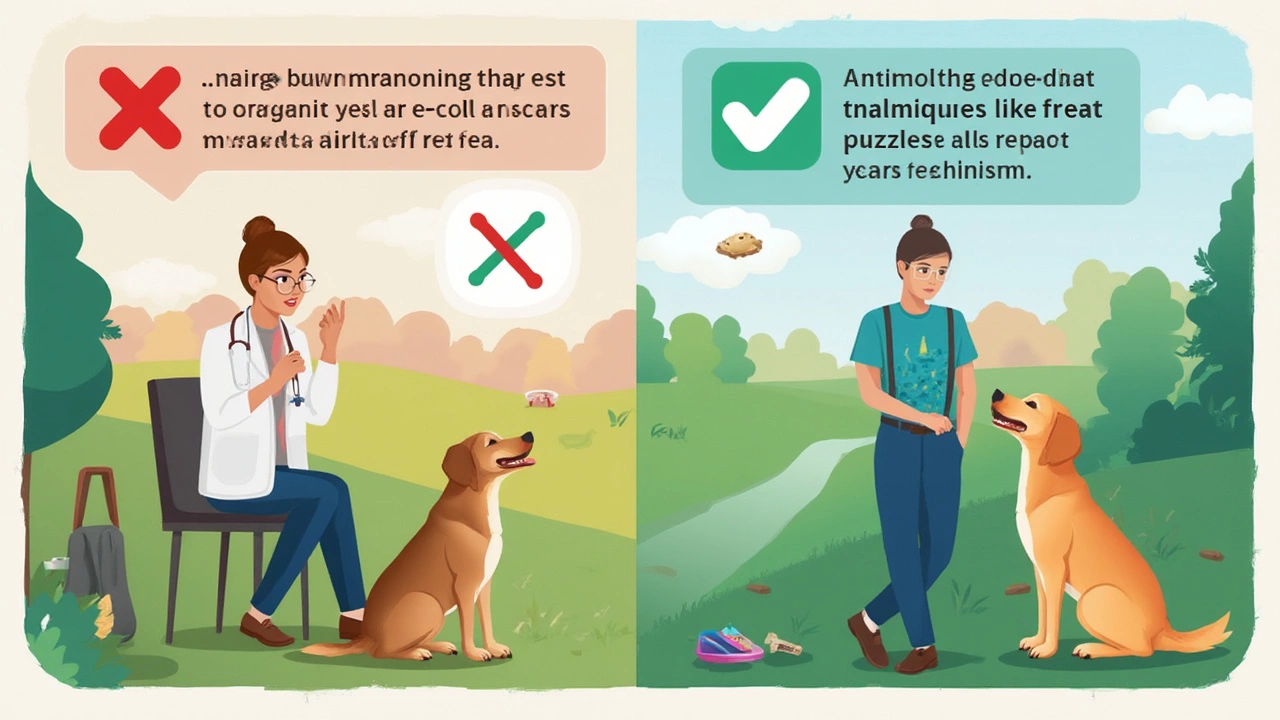Ever find yourself staring at those e-collars in the pet store, wondering if they’re really something vets stand by? You’re definitely not alone. Training a dog can be way harder than it looks, and the stuff you hear about shock collars or e-collars is all over the place.
Here’s the straight talk: vets generally want what’s safest and most effective for your pup, but e-collars aren’t everyone’s first pick. Some will tell you they have a place—usually as a last resort in tough cases—while others say nope, not worth the risk. You might be surprised by how divided the opinions are, even among professionals.
If you’re here because you’re struggling with a dog who’s not listening or showing some stubborn behavior, don’t worry. I’ll break down what these collars actually do, what animal experts really think about them, and what options might make a real difference—without stressing out your dog.
- What Are E-Collars Anyway?
- Where Vets Stand on E-Collars
- When Do Vets Ever Recommend E-Collars?
- Risks, Benefits, and Misconceptions
- More Humane Training Alternatives
What Are E-Collars Anyway?
First off, e-collars—also called e-collars for dogs, remote training collars, or shock collars—aren’t those comfy cones pets wear after surgery (yes, it’s confusing). In this case, “e” stands for electronic. The main point of an e-collar is to correct or manage a dog’s behavior by using a remote to send some kind of stimulation: usually a static shock, vibration, or beep.
E-collars have a strap that fits around your dog’s neck and a receiver box on the collar itself. You hold the remote. When you push the button, your dog feels the effect. Most collars let you choose different levels of stimulation. Some even let you pick between a sound, a buzz, or that electric zap.
- Shock/stimulation: Delivers a mild electric pulse. Brands always say it’s "harmless," but that’s debated.
- Vibration: Makes the collar shake. Some owners use this for hard-of-hearing dogs.
- Sound: Emits a beep or tone to get your dog’s attention.
People use these dog training collars for everything from teaching off-leash recall to stopping nuisance barking or chasing. A lot of brands promise quick results, but the science is pretty mixed. According to a 2020 study out of the UK, half of dog owners who used e-collars saw some improvement, but nearly 40% also felt their dog became more nervous or jumpy. Check out the simple breakdown here:
| Feature | What It Does | Common Settings |
|---|---|---|
| Shock | Static pulse to interrupt behavior | Levels 1-15+ |
| Vibration | Collar vibrates as a warning | Often paired with or replaces shock |
| Sound | Audible beep or tone | Single setting or multiple tones |
So, while dog training collars sound simple, there’s a lot more to think about—especially if you care about your dog’s comfort and long-term trust. Knowing exactly how these collars work—and what risks come with the design—matters way more than you’d think.
Where Vets Stand on E-Collars
This topic is surprisingly loaded, even in the vet world. Most vets line up on one side or the other when it comes to e-collars for dogs, but you won’t see total agreement. The biggest reason? How these collars actually work. E-collars deliver a small electrical pulse when a dog barks, pulls, or does something the owner wants to curb. Some people call them shock collars, which definitely sounds scary, but not all e-collars use strong shocks—some only beep, vibrate, or send a light tap.
Now, the main veterinary organizations—like the American Veterinary Society of Animal Behavior (AVSAB)—pretty much say e-collars shouldn’t be your go-to solution. Their official position is that positive, reward-based training works better and is easier on the dog. They point out that corrections with pain or fear can backfire, making behavior worse or causing stress.
Here’s where it gets a bit nuanced. Some vets, especially ones who specialize in canine behavior, say there are rare cases where dog training collars like e-collars are the only thing left—when a dog’s behavior is dangerous and nothing else has worked. Even then, they always recommend careful coaching with a pro who really knows humane training, and never suggest owners just try it out by themselves.
There are vets who remain open-minded if the device only uses sound or vibration, but many agree that standard shock modes carry more risk than reward.
| Type of Collar | Common Vet Opinion | When Considered? |
|---|---|---|
| Shock E-Collar | Usually not recommended | Rare, extreme cases with supervision |
| Vibration/Beep E-Collar | Sometimes considered | Non-painful correction for stubborn habits |
For the average dog and owner, most vets steer folks towards options that don’t involve pain or fear. Their main goal? A well-behaved, happy dog—without risky shortcuts.

When Do Vets Ever Recommend E-Collars?
If you ask ten vets about e-collars for dogs, most won’t recommend them straight away. But there are rare cases, and they almost always come with a big list of rules and warnings. Usually, this happens when a dog’s behavior is actually dangerous—think aggressive attacks, serious chasing problems, or ignoring commands that put them or others at risk. For example, if a dog’s dashing toward traffic or livestock no matter what you try, an e-collar might make the difference and keep everyone safer.
The key thing is vets never hand over a shock collar and say, “Good luck!” They set guidelines. Here’s when a vet might go down this road:
- Other training methods have been tried for weeks or months—treats, positive reinforcement, clickers—and nothing worked.
- The dog’s unsafe habits are life-threatening, like charging after cars, refusing to come when called, or biting people and animals.
- Owners are working closely with a professional trainer who really knows modern e-collar use (not just slapping it on and pressing buttons).
- The dog is physically and mentally healthy, with no pain, fear issues, or anxiety disorders that could get worse with a collar.
A 2022 survey from the American Animal Hospital Association found that only about 10% of vets would even consider dog training collars that use shock—almost always as a backup when nothing else helps. And, most said they’d only recommend it under expert supervision.
Even then, you’ll hear “lowest setting,” “short sessions,” and “never use as punishment” over and over. Vets are always careful because misuse is way too easy and can really hurt the bond you have with your pup.
Risks, Benefits, and Misconceptions
Honestly, e-collars for dogs are loaded with both risks and some claimed benefits, but lots of pet owners get the wrong idea about them. Let’s be real: these tools can work quickly for stopping certain problem behaviors, like chasing cars or ignoring recall, which is why some folks lean on them. But there’s a lot that gets lost in the hype.
First up, the risks. Even at low settings, e-collars can cause stress, fear, or anxiety in a dog. If misused, a collar can make a dog more aggressive or super nervous around people, especially the person holding the remote. The American Veterinary Society of Animal Behavior says that punishment-based training (which most dog training collars rely on) often increases unwanted behaviors over time.
Physical risks include burns or sores if the collar is left on too long, plus vocalization or flinching when shocked. That’s super uncomfortable for any dog and definitely not what most of us are after when we just want better behavior. Here’s a quick look at how these risks stack up:
| Risk Type | Description |
|---|---|
| Physical injury | Burns, wounds, or skin irritation from collar contact points |
| Emotional stress | Increased fear, anxiety, or aggression around people or situations |
| Training setbacks | Loss of trust or worsened behavior if dog doesn’t understand why collar activates |
On the benefit side, there’s no sugarcoating it—sometimes dog behavior is truly dangerous (think: running toward traffic) and traditional methods just aren’t cutting it. That’s where a few vets believe e-collars for dogs could make sense, if—and this is big—they’re used by someone who’s trained, knows what to watch for, and never uses the highest settings.
The biggest misconception? That e-collars are a shortcut for lazy training. Nope. They can actually require just as much (if not more) attention, timing, and training knowledge as positive methods. Another myth: all dog collars that use static are cruel. Not true—some feature vibration or sound only, which might be less stressful for certain dogs, but you have to know your dog’s limits.
If you ever do consider one, always check with your vet or a certified animal behaviorist first. They can help you figure out if there’s a safer way—or if the situation really does call for an e-collar for dogs under strict guidance.

More Humane Training Alternatives
Thinking about ditching e-collars for dogs? Good call. Most vets and qualified trainers actually recommend positive training methods way before reaching for anything that zaps, vibrates, or beeps at your dog. These techniques get results, and they don’t freak your dog out or mess with that trust you’ve built.
The gold standard? Positive reinforcement. Basically, you reward your dog when they do something right, turning good behavior into their new habit. Rewards can be treats, toys, or even just happy attention—whatever gets your pup’s tail wagging.
- Clicker Training: This is huge in the training world. With a small clicker, you "mark" good behavior, then give a treat. Dogs usually catch on super fast.
- Lure and Reward: Use treats to guide your dog into positions like sit or down, then pay up when they do what you want. No physical force needed.
- Reset and Redirect: Instead of punishing a bad behavior, show your dog something better to do, like sitting when guests arrive instead of jumping up.
- Verbal Praise and Affection: Simple and effective. For some pups, a happy "Good boy!" carries more weight than any treat.
Some dogs just need a little help focusing. That’s where gear like front-clip harnesses or gentle head collars comes in. They give you more control during walks without the risk of pain or fear.
| Training Tool | Main Benefit | Vet Recommendation |
|---|---|---|
| Treat Pouches | Quick rewards on the go | Yes, encouraged |
| Clickers | Clear communication during training | Widely backed by trainers |
| Front-Clip Harnesses | No choking, better leash control | Highly recommended |
| Head Collars | Helps with strong pullers | Suggest for specific cases |
Honestly, your best bet is patience and a clear plan. Training takes time, especially with stubborn dogs or certain breeds. Don’t be afraid to book a session with a certified dog trainer—many now teach completely humane dog collars and force-free methods. You want something that not only changes the behavior but keeps your dog happy and confident in the process. That bond you build will last long after the treats are gone.
